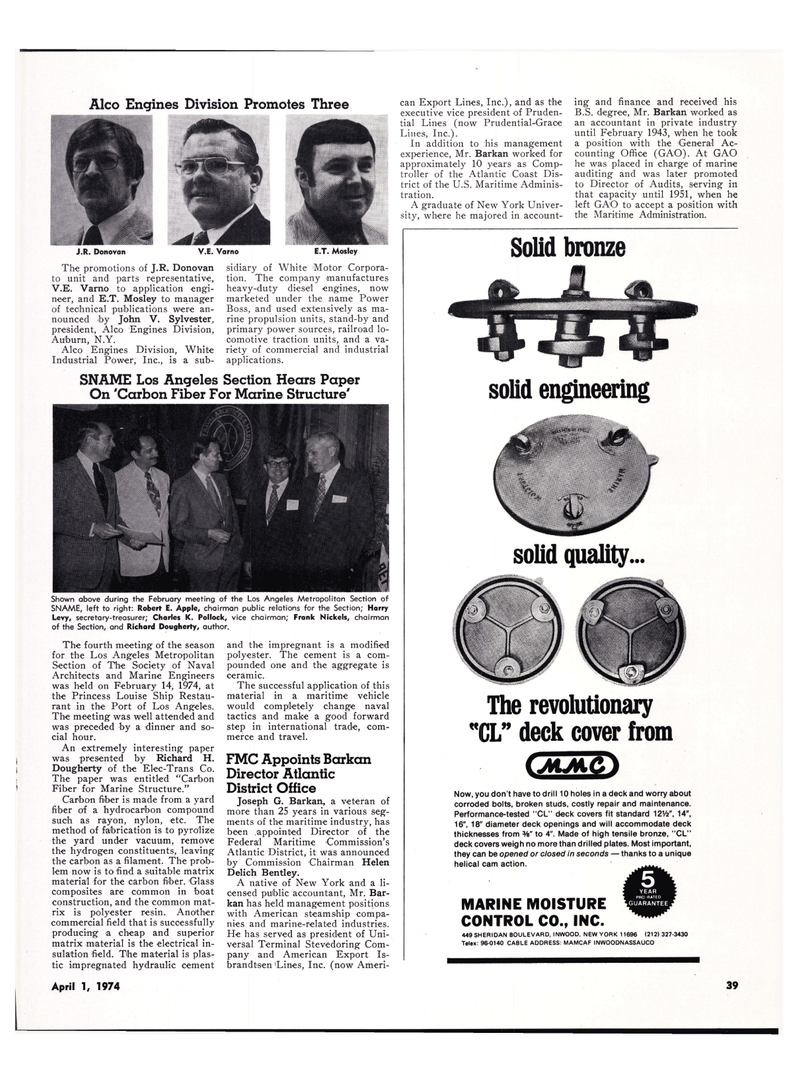
Page 36: of Maritime Reporter Magazine (April 1974)
Read this page in Pdf, Flash or Html5 edition of April 1974 Maritime Reporter Magazine
Alco Engines Division Promotes Three
J.R. Donovan V.E. Varno E.T. Mosley
The promotions of J.R. Donovan to unit and parts representative,
V.E. Varno to application engi- neer, and E.T. Mosley to manager of technical publications were an- nounced by John V. Sylvester, president, Alco Engines Division,
Auburn, N.Y.
Alco Engines Division, White
Industrial Power, Inc., is a sub- sidiary of White Motor Corpora- tion. The company manufactures heavy-duty diesel engines, now marketed under the name Power
Boss, and used extensively as ma- rine propulsion units, stand-by and primary power sources, railroad lo- comotive traction units, and a va- riety of commercial and industrial applications.
SNAME Los Angeles Section Hears Paper
On 'Carbon Fiber For Marine Structure'
Shown above during the February meeting of the Los Angeles Metropolitan Section of
SNAME, left to right: Robert E. Apple, chairman public relations for the Section; Harry
Levy, secretary-treasurer; Charles K. Pollock, vice chairman; Frank Nickels, chairman of the Section, and Richard Dougherty, author.
The fourth meeting of the season for the Los Angeles Metropolitan
Section of The Society of Naval
Architects and Marine Engineers was held on February 14, 1974, at the Princess Louise Ship Restau- rant in the Port of Los Angeles.
The meeting was well attended and was preceded by a dinner and so- cial hour.
An extremely interesting paper was presented by Richard H.
Dougherty of the E lee-Trans Co.
The paper was entitled "Carbon
Fiber for Marine Structure."
Carbon fiber is made from a yard fiber o'f a hydrocarbon compound such as rayon, nylon, etc. The method of fabrication is to pyro'lize the yard under vacuum, remove the hydrogen constituents, leaving the carbon as a filament. The prob- lem now is to find a suitable matrix material for the carbon fiber. Glass composites are common in boat construction, and the common mat- rix is polyester resin. Another commercial field that is successfully producing a cheap and superior matrix material is the electrical in- sulation field. The material is plas- tic impregnated hydraulic cement and the impregnant is a modified polyester. The cement is a com- pounded one and the aggregate is ceramic.
The successful application of this material in a maritime vehicle would completely change naval tactics and make a good forward step in international trade, com- merce and travel.
FMC Appoints Barkan
Director Atlantic
District Office
Joseph G. Barkan, a veteran of more than 25 years in various seg- ments of the maritime industry, has been appointed Director of the
Federal Maritime Commission's
Atlantic District, it was announced by Commission Chairman Helen
Delich Bentley.
A native of New York and a li- censed public accountant, Mr. Bar- kan has held management positions with American steamship compa- nies and marine-related industries.
He has served as president of Uni- versal Terminal Stevedoring Com- pany and American Export Is- brandtsen 'Lines, Inc. (now Ameri- can Export Lines, Inc.), and as the executive vice president of Pruden- tial Lines (now Prudential-Grace
Lines, Inc.).
In addition to his management experience, Mr. Barkan worked for approximately 10 years as Comp- troller of the Atlantic Coast Dis- trict olf the U.S. Maritime Adminis- tration.
A graduate of New York Univer- sity, where he majored in account- ing and finance and received his
B.S. degree, Mr. Barkan worked as an accountant in private industry until February 1943, when he took a position with the General Ac- counting Office (GAO). At GAO he was placed in charge of marine auditing and was later promoted to Director of Audits, serving in that capacity until 1951, when he left GAO to accept a position with the Maritime Administration.
MARINE MOISTURE
CONTROL CO., INC. ^ 449 SHERIDAN BOULEVARD, INWOOD, NEW YORK 11696 (2121 327-3430
Telex: 96-0140 CABLE ADDRESS: MAMCAF INWOODNASSAUCO
Solid bronze solid engineering solid quality
The revolutionary "CL" deck cover from
Now, you don't have to drill 10 holes in a deck and worry about corroded bolts, broken studs, costly repair and maintenance.
Performance-tested "CL" deck covers fit standard 121/2", 14", 16", 18" diameter deck openings and will accommodate deck thicknesses from %" to 4". Made of high tensile bronze, "CL" deck covers weigh no more than drilled plates. Most important, they can be opened or closed in seconds — thanks to a unique helical cam action. ^^
April 1, 1974 39

 35
35

 37
37
